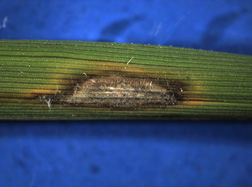|

DNA markers in rice
have been found that tag genetic resistance to rice blast fungus, a disease
that destroys enough rice to feed more than 60 million people each year. This
is a typical lesion caused by the fungus. Click the image for more
information about it.
|
|

|
Markers for Rice Blast Resistance Discovered
By
Alfredo Flores
September 12 , 2008
Genetic markers for a gene that helps rice resist a destructive fungus
have been discovered by Agricultural Research
Service (ARS) scientists.
Plant molecular geneticist
Robert
Fjellstrom and research leader
Anna
McClung at the ARS
Rice
Research Unit in Beaumont, Texas, found the markers that protect rice from
the rice blast fungus Magnaporthe oryzae, which causes blast disease.
Rice blast disease causes economically significant crop losses
annually and is estimated to destroy enough rice to feed more than 60 million
people. The fungus can infect the root, leaves, and stems of the plant. Once
embedded, the fungus can produce structures that can also invade the plant's
vascular system, blocking the transport of nutrients and water, and producing
lesions on the aboveground plant parts.
The genetic markers are linked to the Pi-z blast resistance gene in
rice. The Pi-z gene confers resistance to many strains of the blast fungus in
the United States and throughout the world, so these markers are quite valuable
for selecting and breeding disease resistant rice cultivars.
The
markers are also highly beneficial because they are located closer to the Pi-z
gene than previously developed markers for this gene, making them extremely
accurate in predicting the gene's presence. Rice breeders have already been
able to use these markers to select for highly resistant rice cultivars in
California and Texas.
Preliminary analysis of a cross between the rice varieties "Zenith"
and "Pi-2"--which carry the Pi-z and Pi-2 resistance genes,
respectively--indicate that the genetic factors encoding their separate
resistance reactions are not the same, but are very tightly linked. The Pi-z
markers reported here provide rice breeders and geneticists with a valuable
tool for marker-aided selection of the Pi-z gene.
ARS is a scientific research agency of the
U.S. Department of Agriculture.